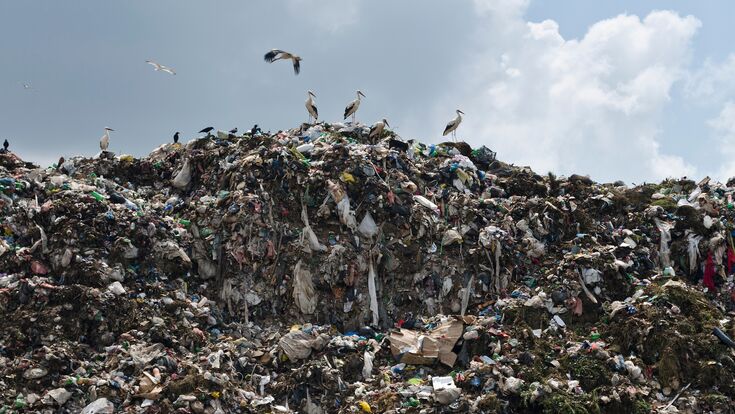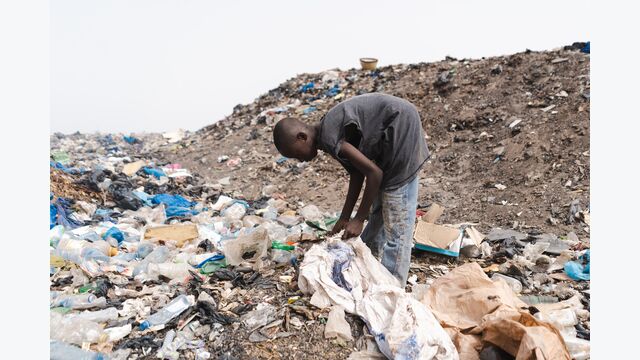Climate Change : Closing Open Dumpsites: Protecting Health and the Environment

Of the approximately 2.24 billion tonnes of solid waste generated globally each year roughly 40 per cent ends up in open dumpsites, particularly in cities in middle and lower-income countries lacking proper waste collection systems, according to the United Nations Environment Programme UNEP. In many African cities up to 90 per cent of waste is openly dumped. In the region of Latin America and the Caribbean, it's about 45 per cent.
While open dumping sure is a cost-effective waste management option, it is also hazardous to both the environment and public health. Emissions such as dioxins and furans, as well as hazardous substances like mercury, contribute to air, water and soil pollution.
The surrounding communities and especially waste pickers working on those sites are therefore at constant risk of inhaling and ingesting toxic substances. Furthermore, there is a threat of diseases spreading due to poor sanitation and the presence of insects and vectors, UNEP states. But simply closing the dumpsites is not enough and also has negative socio-economic effects. Organisations such as UNEP and the International Solid Waste Association (ISWA) therefore are in favour of an integrated waste management approach. This involves working with a wide range of stakeholders to provide waste collection services, raise awareness of sound waste management, enforce policies and legislation, implement a waste management chain including recycling and environmentally sound final disposal, establish monitoring mechanisms and strengthen administrative and institutional capacity. After all, closing dumpsites makes an essential contribution to reducing greenhouse gases, soil and air pollution
Waste Management World talked with James Law, the Chair of the ISWA Working Group on Landfill and the Task Force on Closing Dumpsites Initiative, about the environmental and public health impacts of open dumpsites, the key steps and profitability of dumpsite closures and the advantages and disadvantages of biomining.
Related article: Waste Pickers at the Forefront of a Global Just Transition and Plastic Treaty Movement
Can you explain the potential environmental and public health risks associated with the operation of an open dumpsite?
Since the operation of a dumpsite does not include the application of daily cover or waste compaction and also it does not have a bottom liner or gas and leachate collection system, the most common risks are groundwater contamination, fire hazards that could generate black carbon fume and toxic gases to impact the air quality and thus affect the public health in the immediate area or areas miles away in downwind direction. The gas emissions from dumpsites have a direct impact on climate change. Then there are odour issues, either from the decomposed waste mass itself or from the leachate seep outbreaks located on the side slopes of a dumpsite. The leachate seeps will impact the surface water bodies such as rivers and lakes nearby in the downstream direction as well as the groundwater below the dumpsite.
Most dumpsites have people or informal waste pickers on them. Therefore they have a direct impact on their health and safety point of view.

What are the key steps in the process of closing a dumpsite?
There are a few key steps when considering closing a dumpsite:
- There is a need for immediate improvements in waste management such as education and outreach programs to the general public, improving waste and recycling collection programs and routing coverage areas, and identifying waste and recycled material destination points. It is also important to identify in the new program who is taking, treating or recycling and reusing various waste materials.
- It is necessary to form a strong team of informal waste recyclers, waste collection companies, recyclers, and the local government. The social management of a closing dumpsite must be addressed upfront to take care of the informal waste recyclers and pickers. This should be an important part of the governance for change to be successful.
- As there are many necessary infrastructures such as transfer stations, recycling centres, and waste treatment facilities, when transitioning from dumpsite operation to sanitary landfill operation, the siting of a new sanitary landfill must happen prior to the closing of a dump site. The sanitary landfill design, construction, and operation must follow strict industry standards and regulations. One of the ISWA Working Group on Landfill white paper publications talks about the impact of management choices on landfill methane emissions. The methodology presented in the paper should be considered and applied to any dumpsite that plans to transition into sanitary landfill operation with increased recycling efforts and organic waste diversion from the landfill operation.
- Once the new landfill is taking in diverted or new waste from the dumpsite, it is time to evaluate and design a closure plan and a cover system for the dumpsite. Any issues or challenges related to site contamination must be investigated and evaluated to come up with a remediation plan before closing the dumpsite. A gas or leachate collection system may be necessary to address gas emission that impacts climate change or groundwater contamination that impacts the quality of drinking water.
- Finally, a closure cover system can be constructed along with an end-use of the site if so desired.
- A closed dumpsite needs to be regularly monitored and maintained throughout its life until such threats as the ground surface settlement, final slope stability, gas emission and groundwater quality have reached a point of general acceptance as a „stabilized waste mass“ by industry-standard or governing regulations.
- A closed dumpsite end-use, if it is designed and planned properly, will become a public asset instead of a liability and add value to the community such as using it as a recreation park, recycling centre, walking trail, and other community activities.
What technologies are available to analyse the composition?
The technology used is pretty basic and mechanical in nature when someone wants to analyse a waste composition delivered to any landfill. A simple approach is to randomly obtain a bucketful of representative waste samples using an excavator or a frontend loader right after incoming trucks have dumped waste at the working face. Then it is weighed and mixed into a bigger waste pile with a known total weight. From this pile, approximately a quarter of it is pulled from it and weighed and taken to a sorting station that has bins, a weight scale, and workers. The waste is carefully sorted and then weighed by material type. Each material type weight is then compared with the total weight to calculate its percentage by weight for this specific sampling. There may be a series of 4 to 5 sampling events, depending on the resources and manpower available for this exercise.
As there are many necessary infrastructures such as transfer stations, recycling centres, and waste treatment facilities, when transitioning from dumpsite operation to sanitary landfill operation, the siting of a new sanitary landfill must happen prior to the closing of a dump site.James Law
How do you assess the contamination levels and potential hazards of a dumpsite before commencing closure activities?
There are standard testing and sampling procedures available for the evaluation of gas emission, air quality, and groundwater quality as determined by minimum acceptable contamination levels or the presence of certain constituents that indicate potential hazards.
What are some of the most common challenges encountered during dumpsite closure and how do you address them?
The most common challenges encountered during dumpsite closure include dealing with steep side slopes, fire, odour, leachate seeps, gas well installation, informal waste pickers, and availability of open area that can be used for a construction staging area for construction equipment, its maintenance, and construction material stockpiles. Most of these challenges should have been addressed during the design phase of a closure plan.
Then there is always the financial and resource availability to close a site.
How do you ensure proper disposal of waste materials during the closure process to prevent further environmental contamination?
Any access waste material resulting from the flattening of a waste slope or during gas well installation or redefining the waste limits should be properly loaded and transported to a designated waste disposal facility following the standard disposal protocol.
Are there any considerations or strategies for managing leachate and controlling air emissions during dumpsite closure?
Yes, there should be plans in place to handle gas emissions as well as leachate seeps or outbreaks during dumpsite closure construction. Gas can be collected at a gas well or a flare station and destroyed by an open flare system. Likewise, leachate if encountered, should be collected and sent to an off-site wastewater treatment facility. Sometimes a cutoff slurry wall can be constructed to contain lateral movement of the contaminated liquid from leaving the site and a submerged pump can be used to collect and load to a tank truck for off-site disposal and treatment.
Related article: How detection wells converted to low-discharge pumping wells can help stabilise leachate plumes from landfills
What are the climate benefits of closing dumpsites?
It is a known fact that gas emissions from dumpsites or landfills amount to about one-third of the world's methane gas emissions and have a direct impact on climate change. Closing dumpsites, collecting to destroy and prevent it from release into the atmosphere have a direct reduction of carbon emissions to the atmosphere and thus direct climate benefits.
How can the closure of a dumpsite be made profitable?
When we combine the closure with its end-use planning, there is a good chance that the combined efforts of realising carbon credits and community usage of the closed area for passive use and activities can achieve positive cash flow and profitable operations.
What are the advantages and disadvantages of biomining?
There are many:
Advantages: An opportunity to recover resources, material recycling, reuse as construction materials, eliminate post-closure construction and long-term monitoring costs, and free up landfill footprint for new sanitary landfill operations or other land uses such as high-rise buildings and parks. In addition, long-term environmental liability is reduced to a minimum when clean-up of ground contamination is done properly.
Disadvantages: impact on the environment during biomining is significant and must be dealt with during initial site evaluation and analysis, by careful planning before any excavation addressing every aspect of activities and management during operations, such as an execution plan with various phasing and depths that provides sufficient factor of safety against instability, potential for fire breakout as waste mass is exposed to atmosphere air, bad odour management plan to its surrounding and to the people who live nearby, air quality may get worsen and affecting people’s health, and safety of the workers doing biomining. It will take a long duration of time to do biomining so there must be a comprehensive plan on how to handle and store sorted materials in multiple piles, depending on the size of the dumpsite and the number of equipment and manpower used.
If there is no storage area at the dumpsites, then all sorted materials generated each day must leave the site to designated locations for reuse, reprocessing or treatment to turn them into useful materials. Therefore, before biomining can begin, an alternate site must be developed and operational to receive new waste and/or rejected material from biomining operations.
Related article: Rags to Riches? The Urban Waste Management in India Saga
We must realise that closing a dumpsite is about the people, not waste!James Law
Can you discuss any successful case studies or examples of dumpsite closures, highlighting key strategies and outcomes?
In the US since the early 1990s, regulations were strictly implemented for any dumpsites that were required to be closed, remediated, or upgraded to continue taking in new waste according to new regulations. So the key strategy based on past experience is to perform site evaluation concerning waste limit, waste composition and density, and any site contamination or leachate flowing beyond the property limit. Then once an alternate site is developed and accepting new waste, a closure plan and construction drawings for a dumpsite can be prepared to install a final closure system with a final grading plan that gives an acceptable factor of safety against slope sliding. Sometimes this work can incorporate the end-use of the site after closure, such as a passive-use recreational park, walking trails, kite flying and so on.
One of the recent year successful dumpsite closure projects was presented in one of the publications under ISWA’s Task Force on Closing Dumpsites Initiatives, „Climate Benefits Due to Dumpsite Closure: Three Case Studies, September 2019.“ It is the Estrutural Disposal Site in Brasìlia, Brazil. It was a huge dumpsite in service for more than 50 years with about 2,000 people who were living in and around the dumpsite. The Estrutural dumpsite and the new sanitary landfill ASB (Aterro Sanitário de Brasilia) receive all the MSW which is collected in the 31 administrative regions of the Brasilia Federal District.
The success of this dumpsite closure was due to strong cooperation with the informal sector and was established to reallocate informal waste pickers into the formal sorting facilities by promoting their informal organisational structures into cooperative systems. With the will of the city officials and the people, this closure project proves that a dumpsite can be closed in a relatively short amount of time, leading to a more environmentally sound waste management system. This success story also shows the possibility and feasibility of steering a change in the habits of the informal sector through strong political will and the people, improving the working conditions of the people and transforming it into a formal system.
How do you prioritise which dumpsites to close first, especially in areas with limited resources?
I believe that its location is going to determine which dumpsite(s) in a country need to be closed first or at least put it in order of importance that impacts the health and safety of the people and stakeholders in concern. Sometimes the real estate value decides that or an influential politician or party decides that.
What strategies can be used to address any social or economic impacts that may result from the closure of dumpsites, such as loss of livelihoods or changes in land use?
We must realise that closing a dumpsite is about the people, not waste!
The primary objective is to address the social issues of the economic impact resulting from dumpsite closure. There are many precedent solutions before us, such as formally converting those informal waste pickers into new facility employees at a new landfill or recycling or composting centres. Obviously, the new landfill facility needs to be constructed as a secured fenced-in property in order to prevent „new“ informal waste pickers from coming into the facility.
What are some key lessons or best practices that can be applied to future dumpsite closure projects?
ISWA has a few key publications that should be used as guidance for any dumpsite closure projects. These are:
- A Roadmap for Closing Waste Dumpsites, September 2016
- Landfill Operational Guidelines, 3rd Edition, September 2019
- Climate Benefits Due to Dumpsite Closure: Three Case Studies, September 2019
- The Impact of Landfill Management Choices on Methane Emissions, April 2023
(The publications are available here.)
Lessons learned when closing a dumpsite are, that we must engage all stakeholders and in particular the local government decision-maker(s), an integrated solid waste management plan, and the social aspects of the people who are impacted by the closing of dumpsite on their livelihoods.
Looking ahead, what are some emerging trends or developments in the field of dumpsite closure and waste management?
As the local population is more educated and knowledgeable of something better out there, it is important to introduce new technologies into waste management. For example, using new geosynthetic material such as power cap closure turf as a cover system, thermal hydrolysis for RDF biofuel production from the organic fraction of the waste stream, smaller engines for gas generation utilisation projects for smaller dumpsites, material recovery and reuse of sorted legacy waste, plastic reuse into construction material such as plastic pins for slope stabilisation projects and plastic recycling into roadway asphalt, biomining in certain countries like in India is gaining momentum (but with great caution to avoid negative impact to the environment and public health) etc.


